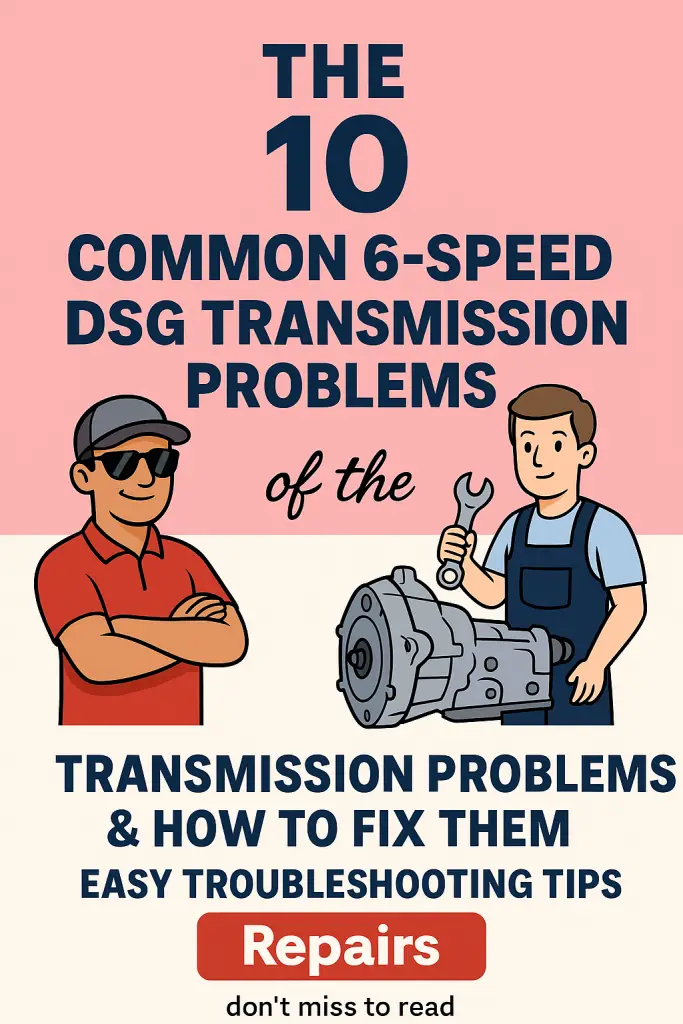Common 6-Speed DSG Transmission Problems & How to Fix Them

Let’s Talk DSG Drama
If you’re reading this, chances are your 6-speed DSG transmission is acting up… or you’re worried it might. Maybe you’ve felt a weird shudder when pulling away from a stoplight, or your car hesitated for just a split second before finding the right gear. Whatever the symptom, I get it — DSG problems can be both frustrating and wallet-draining if you don’t know what’s going on.
I’ve spent more hours than I’d like to admit talking shop about DSGs with fellow gearheads, pulling transmissions apart in the garage, and learning (the hard way) which fixes actually work. And trust me, once you understand the quirks of a DSG, it’s a lot less scary to deal with.
So, let’s break it all down: the common problems, why they happen, and how you can fix them before they turn into a “call-a-tow-truck” situation.
1. Mechatronic Unit Failure – The DSG’s Brain Meltdown
The mechatronic unit is basically the brain of your DSG. It controls clutch engagement, gear changes, and overall shifting logic.
Symptoms You’ll Notice:
- Sudden loss of drive
- Jerky or delayed shifts
- Transmission warning light on the dash
- Limp mode activation (a.k.a. the car’s way of saying, “Nope, not today”)
Why It Happens:
The 6-speed DSG’s mechatronic unit is sensitive to heat and contaminated transmission fluid. Over time, solenoids can fail or the internal hydraulic system can lose pressure.
How to Fix It:
- Short-term: Sometimes, a mechatronic reset via diagnostic software (like VCDS) can temporarily fix minor glitches.
- Long-term: Replacement is usually necessary. OEM replacements are pricey, but rebuilt units can save you hundreds.
- Always pair the new unit with a DSG fluid and filter change to prevent an instant repeat failure.
Pro Tip: Keep your DSG fluid clean and serviced every 40k miles — it’s the cheapest insurance you can buy for this problem.
2. Clutch Pack Wear – The Slipping Game
Your DSG uses two wet clutches that handle odd and even gears separately. When one starts to wear, you’ll notice things feel… off.
Symptoms You’ll Notice:
- Slipping under heavy acceleration
- Strange burning smell (never a good sign)
- “Hunting” between gears
- RPMs climbing but speed not matching
Why It Happens:
Aggressive driving, stop-and-go traffic, and neglected DSG services cause clutch friction material to wear out faster. And once the material is gone? Metal-on-metal wear begins.
How to Fix It:
- Replace the clutch pack. If you catch it early, you can just swap clutches without replacing the whole gearbox.
- If there’s internal damage, you may need to resurface or replace the flywheel too.
FYI: DSG clutches can handle a lot, but they’re not invincible. Treat them well and they’ll last far longer.
3. Gear Selector Sensor Issues – The Confused Shifter
Sometimes, your DSG doesn’t know what gear it’s in because the selector sensor is acting up.
Symptoms You’ll Notice:
- “PRNDS” lights flashing on the dash
- Transmission refusing to engage drive or reverse
- Sudden shift to neutral while driving (yep, terrifying)
Why It Happens:
The sensor can fail due to electrical faults, worn contacts, or even simple corrosion in the wiring.
How to Fix It:
- Check for stored fault codes first — sometimes it’s a wiring issue.
- If the sensor itself is bad, replacement is straightforward but requires gearbox disassembly in some cases.
- Keep connectors clean and moisture-free to prevent repeat issues.
4. DSG Shudder – The Awkward First Date of Gear Changes
If your DSG shudders when you accelerate gently, you’re not alone. This is one of the most common complaints.
Symptoms You’ll Notice:
- Vibration at low speeds (especially in 1st and 2nd)
- Jerky take-offs
- Smoothness improves when you accelerate harder
Why It Happens:
Shudder is usually caused by contaminated DSG fluid or early clutch wear. The wet clutches rely on clean, high-quality oil to function smoothly.
How to Fix It:
- Perform a DSG fluid and filter change. This alone can solve many shudder issues.
- If fluid change doesn’t help, inspect clutch packs for wear.
- Avoid “feathering” the throttle excessively in traffic — DSGs like decisiveness.
5. Overheating – The DSG’s Silent Killer
Heat is the enemy of any transmission, but DSGs are especially sensitive.
Symptoms You’ll Notice:
- Transmission overheating warning
- Loss of power or limp mode during hot weather
- Increased shift harshness after long drives
Why It Happens:
Aggressive driving, towing, or a failed cooler can cause DSG temps to spike.
How to Fix It:
- Check and replace the DSG oil cooler if it’s clogged or leaking.
- Install an aftermarket upgraded cooler if you live in a hot climate or drive hard often.
- Always use the correct DSG fluid — it has specific heat resistance properties.
6. Software Glitches – The Invisible Gremlins
Sometimes, the problem isn’t mechanical at all — it’s in the code.
Symptoms You’ll Notice:
- Random harsh shifts
- Delayed gear engagement
- Transmission “forgetting” your driving style
Why It Happens:
Outdated DSG software can cause poor shift mapping or fail to adapt properly to your driving habits.
How to Fix It:
- Ask your dealer or a trusted VW specialist about software updates.
- Some tuners offer performance DSG tunes that improve shift speed and reliability.
IMO: If you’re already out of warranty, a good aftermarket DSG tune can make your transmission feel like new.
Preventing DSG Problems – Your Maintenance Cheat Sheet
If you want to avoid the headache (and bill) of DSG repairs, follow these golden rules:
- Change DSG fluid & filter every 40k miles — no excuses.
- Avoid excessive creeping in traffic; DSG clutches don’t like it.
- Let the car warm up before driving aggressively.
- If you notice even small changes in shifting behavior, diagnose early.
When to DIY vs. When to Call a Pro
DIY-Friendly Fixes:
- Fluid & filter changes
- Basic electrical checks
- Resetting adaptations with a scan tool
Call a Pro If:
- You suspect mechatronic failure
- Clutch pack replacement is needed
- There’s severe overheating or internal damage
Conclusion – Keep Calm & DSG On
The 6-speed DSG is an incredible piece of engineering — lightning-fast shifts, great fuel economy, and durability when maintained properly. But like any high-performance part, it needs a little extra love to stay at its best.
If you stay on top of maintenance and address small issues before they snowball, your DSG can easily last well beyond 150k miles. And hey, the next time your buddy complains about their transmission acting up, you can confidently say, “I’ve got you covered.”




![Why Does My Volkswagen Alarm Keep Going Off [How To Fix It]](https://volkswagenbuddy.com/wp-content/uploads/2024/05/why-does-my-volkswagen-alarm-keep-going-off-how-to-fix-it_4477-768x531.jpg)
![Volkswagen Jetta Alarm Keeps Going Off [Proven Fixes!]](https://volkswagenbuddy.com/wp-content/uploads/2024/05/volkswagen-jetta-alarm-keeps-going-off-proven-fixes_4467-768x531.jpg)
